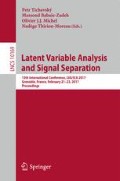Abstract
In this paper, we present an ego noise reduction method for a hose-shaped rescue robot, developed for search and rescue operations in large-scale disasters. It is used to search for victims in disaster sites by capturing their voices with its microphone array. However, ego noises are mixed with voices, and it is difficult to differentiate them from a call for help from a disaster victim. To solve this problem, we here propose a two-step noise reduction method involving the following: (1) the estimation of both speech and ego noise signals from observed multichannel signals by multichannel nonnegative matrix factorization (NMF) with the rank-1 spatial constraint, and (2) the application of multichannel noise cancellation to the estimated speech signal using reference signals. Our evaluations show that this approach is effective for suppressing ego noise.
Access this chapter
Tax calculation will be finalised at checkout
Purchases are for personal use only
References
Impulsive Paradigm Change through Disruptive Technologies Program (ImPACT). http://www.jst.go.jp/impact/program07.html
Namari, H., Wakana, K., Ishikura, M., Konyo, M., Tadokoro, S.: Tube-type active scope camera with high mobility and practical functionality. In: Proceedings of IEEE/RSJ IROS, pp. 3679–3686 (2012)
Deleforge, A., Kellerman, W.: Phase-optimized K-SVD for signal extraction from underdetermined multichannel sparse mixtures. In: Proceedings of IEEE ICASSP, pp. 355–359 (2015)
Barfuss, H., Kellerman, W.: Improving blind source separation performance by adaptive array geometries for humanoid robots. In: Proceedings of HSCMA (2014)
Barfuss, H., Kellerman, W.: An adaptive microphone array topology for target signal extraction with humanoid robots. In: Proceedings of IWAENC, pp. 16–20 (2014)
Aichner, R., Zourub, M., Buchner, H., Kellerman, W.: Post-processing for convolutive blind source separation. In: Proceedings of ICASSP (2006)
Mae, N., Kitamura, D., Ishimura, M., Yamada, T., Makino, S.: Ego noise reduction for hose-shaped rescue robot combining independent low-rank matrix analysis and noise cancellation. In: Proceedings of APSIPA (2016, to be published)
Kitamura, D., Ono, N., Sawada, H., Kameoka, H., Saruwatari, H.: Efficient multichannel nonnegative matrix factorization exploiting rank-1 spatial model. In: Proceedings of ICASSP, pp. 276–280 (2015)
Kitamura, D., Ono, N., Sawada, H., Kameoka, H., Saruwatari, H.: Determined blind source separation unifying independent vector analysis and nonnegative matrix factorization. IEEE/ACM Trans. Audio Speech Lang. Process. 24(9), 1626–1641 (2016)
Kim, T., Eltoft, T., Lee, T.-W.: Independent vector analysis: an extension of ICA to multivariate components. In: Rosca, J., Erdogmus, D., Príncipe, J.C., Haykin, S. (eds.) ICA 2006. LNCS, vol. 3889, pp. 165–172. Springer, Heidelberg (2006). doi:10.1007/11679363_21
Hiroe, A.: Solution of permutation problem in frequency domain ICA, using multivariate probability density functions. In: Rosca, J., Erdogmus, D., Príncipe, J.C., Haykin, S. (eds.) ICA 2006. LNCS, vol. 3889, pp. 601–608. Springer, Heidelberg (2006). doi:10.1007/11679363_75
Kim, T., Attias, H.T., Lee, S.-Y., Lee, T.-W.: Blind source separation exploiting higher-order frequency dependencies. IEEE Trans. Speech Audio Process. 15(1), 70–79 (2007)
Lee, D.D., Seung, H.S.: Learning the parts of objects by nonnegative matrix factorization. Nature 401, 788–791 (1999)
Lee, D.D., Seung, H.S.: Algorithms for non-negative matrix factorization. Proc. NIPS 13, 556–562 (2001)
Cichocki, A., Zdunek, R., Phan, A.H., Amari, S.: Nonnegative Matrix and Tensor Factorizations: Applications to Exploratory Multi-way Data Analysis and Blind Source Separation. Wiley, New York (2009)
Ozerov, A., Févotte, C.: Multichannel nonnegative matrix factorization in convolutive mixtures for audio source separation. IEEE Trans. ASLP 18(3), 550–563 (2010)
Kameoka, H., Yoshioka, T., Hamamura, M., Roux, J., Kashino, K.: Statistical model of speech signals based on composite autoregressive system with application to blind source separation. In: Vigneron, V., Zarzoso, V., Moreau, E., Gribonval, R., Vincent, E. (eds.) LVA/ICA 2010. LNCS, vol. 6365, pp. 245–253. Springer, Heidelberg (2010). doi:10.1007/978-3-642-15995-4_31
Sawada, H., Kameoka, H., Araki, S., Ueda, N.: Multichannel extensions of non-negative matrix factorization with complex-valued data. IEEE Trans. ASLP 21(5), 971–982 (2013)
Murata, N., Ikeda, S., Ziehe, A.: An approach to blind source separation based on temporal structure of speech signals. Neurocomputing 41(14), 1–24 (2001)
Ishimura, M., Makino, S., Yamada, T., Ono, N., Saruwatari, H.: Noise reduction using independent vector analysis and noise cancellation for a hose-shaped rescue robot. In: Proceedings of IWAENC (2016)
Hänsler, E., Schmidt, G.: Acoustic Echo and Noise Control: A Practical Approach. Wiley, New York (2004)
Vincent, E., Gribonval, R., Févotte, C.: Performance measurement in blind audio source separation. IEEE Trans. ASLP 14, 1462–1469 (2006)
Acknowledgments
This work was supported by the Japan Science and Technology Agency and the Impulsing Paradigm Change through Disruptive Technologies Program (ImPACT) designed by the Council for Science, Technology and Innovation, and partly supported by SECOM Science and Technology Foundation. We would also like to express our gratitude to Prof. Hiroshi Okuno and Mr. Yoshiaki Bando for providing experimental data.
Author information
Authors and Affiliations
Corresponding author
Editor information
Editors and Affiliations
Rights and permissions
Copyright information
© 2017 Springer International Publishing AG
About this paper
Cite this paper
Mae, N. et al. (2017). Ego Noise Reduction for Hose-Shaped Rescue Robot Combining Independent Low-Rank Matrix Analysis and Multichannel Noise Cancellation. In: Tichavský, P., Babaie-Zadeh, M., Michel, O., Thirion-Moreau, N. (eds) Latent Variable Analysis and Signal Separation. LVA/ICA 2017. Lecture Notes in Computer Science(), vol 10169. Springer, Cham. https://doi.org/10.1007/978-3-319-53547-0_14
Download citation
DOI: https://doi.org/10.1007/978-3-319-53547-0_14
Published:
Publisher Name: Springer, Cham
Print ISBN: 978-3-319-53546-3
Online ISBN: 978-3-319-53547-0
eBook Packages: Computer ScienceComputer Science (R0)

